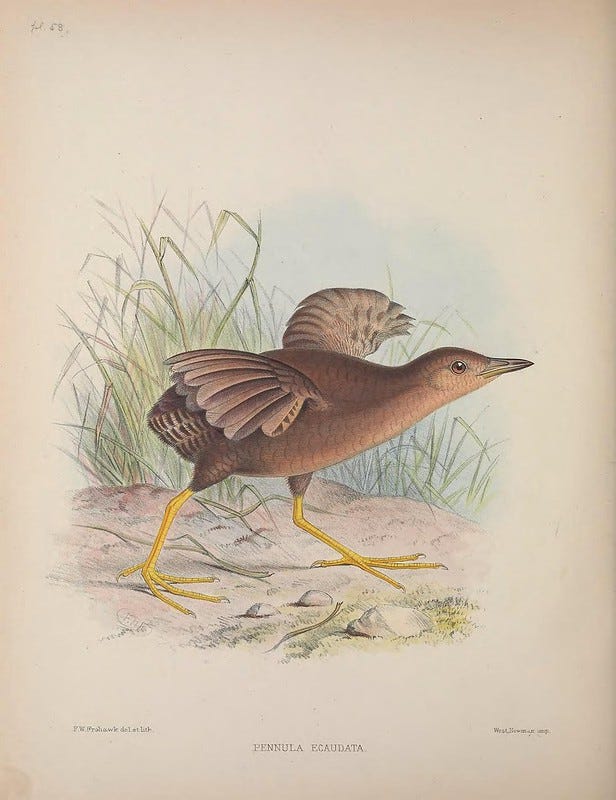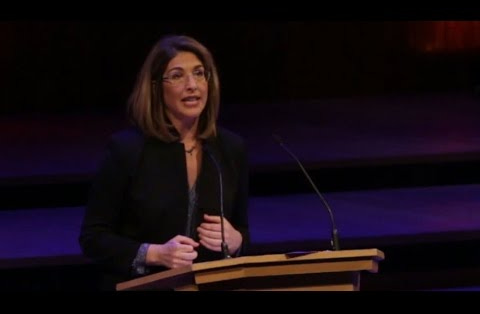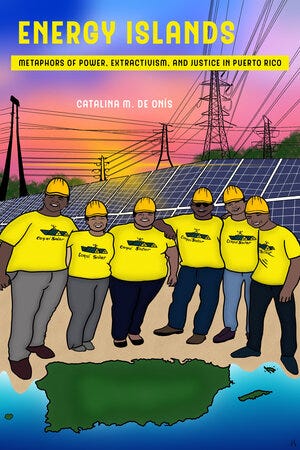🌿Wild Ones # 45: Environmental Communication Digest
'Underestimating the Challenges of Avoiding a Ghastly Future' + Climate guilt brought to you by big oil + Sonic Antarctica + more!

Hi everyone, welcome back to Wild Ones, a weekly digest by me, Gavin Lamb, about news, ideas, research, and tips in environmental communication. If you’re new, welcome! You can read more about why I started Wild Ones here. Sign up here to get these digests in your inbox:
📚 What I’m reading
Commentary: Underestimating the Challenges of Avoiding a Ghastly Future.
In January this year, a ‘perspective article’ was published in the journal Frontiers in Conservation Science, ‘Underestimating the Challenges of Avoiding a Ghastly Future.’
In it, more than a dozen co-authors, mostly in the biological sciences, paint a grim picture of the future humanity faces if we stay on our current trajectory: a sixth mass extinction, biodiversity loss, growing resource conflicts, climate disruption, ecological overshoot, and overconsumption tied to ‘population growth.’
“Humanity,” the authors argue, “is causing a rapid loss of biodiversity and, with it, Earth's ability to support complex life. But the mainstream is having difficulty grasping the magnitude of this loss, despite the steady erosion of the fabric of human civilization.”
As the authors put it, the purpose of the article isn’t to detail what needs to be done, but how to do it. Their call to action is for the scientific community to embrace a communication strategy that must: “eschew reticence, avoid sugar-coating the overwhelming challenges ahead and ‘tell it like it is.’ Anything else is misleading at best, or negligent and potentially lethal for the human enterprise at worst.”
The challenge, in their estimation, is to develop a ‘good communication strategy’ that bluntly conveys the severity of the crisis (to ‘tell it like it is’), but also “without inducing disproportionate feelings of fear and despair.” In other words, experts need to find a balance between climate doom and climate hope if they want the alarming science of climate change to be acted on rather than ignored.
Last week, an interdisciplinary group of environmental researchers published a critical ‘commentary’ on this perspective article:

In their critical response, Jevgeniy Bluwstein and his colleagues don’t dispute the scientific diagnosis laid out in the January perspective piece that the crises we face are really bad and getting worse.
However, Bluwstein et al. push back on three key discourses in the perspective piece:
Scientists must ‘tell it like it is’ in order to motivate political action: “This logic flies in the face of long-established evidence within the social sciences,” write Bluwstein and his colleagues. This perspective relies on a flawed ‘deficit model’ of communication that scientific literacy (or a lack of it) is the main driver of political action on climate. Scientific facts do not simply ‘speak for themselves,’ but are interpreted in all sorts of ways, and sometimes for competing political agendas.
Scientists’ main role is to raise awareness about the ‘ghastly future’ we face: However, millions of people around the world are well aware of this ghastly future because they are living through it today. Assuming that our collective lack of awareness of the climate crisis is the key problem “reinforces a western, white and elitist framing of reality, since the present is already experienced as apocalyptic by many frontline communities.”
Humanity in general and population growth, in particular, are the main drivers of ecological crises: These ‘neo-Malthusian tropes’ are scientifically inaccurate and politically dangerous, write Bluwstein and his colleagues. Last year, I wrote a lengthy piece on this neo-Malthusian discourse common in environmentalism. But I think the main gist of why it’s problematic –why framing the culprit of the climate crisis as ‘humanity,’ or an undifferentiated ‘we’ – was summed up well by Greta Thunberg at Davos:
“Some people say that the climate crisis is something that we will have created. But that is not true. Because if everyone is guilty then no one is to blame. And someone is to blame. Some people, some companies, some decision-makers in particular, have known exactly what priceless values they have been sacrificing to continue making unimaginable amounts of money. And I think many of you here today belong to that group of people.”
Bluwstein et al. conclude that “Scientific messaging alone cannot adequately communicate to the public how socio-ecological crises should be addressed. Framing socio-ecological crises primarily as driven by population growth reveals a western, elitist and neo-colonial bias while it distracts from holding accountable more powerful forces in society.”
Finally, Bluwstein et al. suggest a more expansive idea of what should count as a ‘good communication strategy’ with 3 calls to action for an actively engaged approach to environmental communication:
Don’t just ‘tell it like it is’ in hopes of raising environmental awareness, but stand in solidarity with frontline communities impacted by the climate crisis.
Don’t blur accountability by blaming ‘humanity,’ but use your expertise to shed light on the root structural causes of the climate crisis (things like massive inequality, economic growthism, and fossil-fueled capitalism). And…
Don’t “legitimiz[e] the status quo by appealing to existing political elites” but “actively collaborate with those groups in society that push for and prefigure sustainable ways of living.”
In sum, the upshot of the article for me was that environmental “messaging alone cannot adequately communicate to the public how socio-ecological crises should be addressed.” Scientists, experts, and communication professionals also need to collaborate with organizations and groups “that push for and prefigure sustainable ways of living.” But to think of environmental communication just as ‘messaging’ is a fairly narrow definition of what counts as ‘environmental communication.’
I think of environmental communication as more than just ‘messaging,’ but as a multifaceted activity that also includes the calls to action for ‘active collaboration’ that Bluwstein et al. mention in their commentary.
What if the challenge for environmental communicators to improve a ‘ghastly present’ and avoid a ‘ghastly future’ isn’t just to do activist stuff in addition to messaging stuff (as if ‘communication’ is just about transmitting facts to the public)? What if the challenge is to think of environmental communication in a more expansive sense as first and foremost a community-building activity that “start[s] from the imperative to reconstruct the world in common,” as Achille Mbembe puts it?
👀 What I’m watching


Bathsheba Demuth: "The Reindeer at the End of the World: Apocalypse, Climate, and Soviet Dreams": “Bathsheba Demuth, Assistant Professor of History and Environment and Society at Brown University, is an environmental historian, specializing in the lands and seas of the Russian and North American Arctic. She is interested in the how the histories of people, ideas, places, and non-human species intersect.”
🎧 What I’m listening to
Climate Guilt, Brought to You by Big Oil:
“A new study from Harvard science historians Naomi Oreskes and Geoffrey Supran points to the use of language targeted specifically to downplay the reality of climate change and shift responsibility entirely onto consumers. Geoffrey Supran, the lead author on the study, joins to discuss.”
📰 News and Events
“We are living during extraordinary times, necessitating that we face the immense task of navigating numerous public and personal crises and their aftermaths. The COVID-19 pandemic, economic strife, political turmoil, and struggles for racial justice challenge us as Communication scholars, teachers, and professionals to consider why our contributions matter more than ever before….In accordance with the theme of “Renewal and Transformation,” the convention will focus on how we can engage in the essential tasks of restoration and change.”
Animals to be formally recognised as sentient beings in UK law: “Animals are to be formally recognised as sentient beings in UK law for the first time, in a victory for animal welfare campaigners, as the government set out a suite of animal welfare measures including halting most live animal exports and banning the import of hunting trophies.”
Fact-Checking Idaho’s Wolf Eradication Law: “The state just passed a law calling for 90 percent of its wolf population to be killed. It’s based on fear and lies.” By Wes Siler in Outside Magazine.
📚 Research
New book series on Environmental Communication, Power, and Culture from University of California Press. The first book out in the series is Energy Islands
Metaphors of Power, Extractivism, and Justice in Puerto Rico by Catalina M de Onís.

Rhetoric and frame analysis of ExxonMobil's climate change communications:
“A dominant public narrative about climate change is that “we are all to blame.” Another is that society must inevitably rely on fossil fuels for the foreseeable future. How did these become conventional wisdom? We show that one source of these arguments is fossil fuel industry propaganda. ExxonMobil advertisements worked to shift responsibility for global warming away from the fossil fuel industry and onto consumers. They also said that climate change was a “risk,” rather than a reality, that renewable energy is unreliable, and that the fossil fuel industry offered meaningful leadership on climate change. We show that much of this rhetoric is similar to that used by the tobacco industry…”

💡 Ideas
Sonic Antarctica by Environmental Sound Artist Andrea Polli: "Sonic Antarctica" features natural and industrial field recordings, sonifications and audifications of science data and interviews with weather and climate scientists.”
The conventional wisdom on how to talk about climate change? It’s wrong. By Kate Yoder in Grist.
Going It Alone by Rahawa Haile in Outside Magazine.
We’re Gonna Carry That Weight a Long Time by David Farrier in Emergence Magazine: “David Farrier reflects on the immense burden of materials that mark our place on Earth.”
Can Climate Fiction Writers Reach People in Ways That Scientists Can’t?
A new subgenre of science fiction leans on the expertise of biologists and ecologists to imagine a scientifically plausible future Earth. By Anna Funk in Smithsonian Magazine.


💬 Quotes I’m thinking about
“…in the scientific world there are certain things that could kill your career, and anthropomorphizing is one of those things. But I’m at the point where it’s okay; that’s okay. There’s a bigger purpose here. One is to communicate with people, but also—you know, we’ve separated ourselves from nature so much that it’s to our own demise, right? We feel that we’re separate and superior to nature and we can use it, that we have dominion over nature. It’s throughout our religion, our education systems, our economic systems. It is pervasive. And the result is that we have loss of old-growth forests. Our fisheries are collapsing. We have global change. We’re in a mass extinction.
I think a lot of this comes from feeling like we’re not part of nature, that we can command and control it. But we can’t.”
– Forest ecologist Suzanne Simard, in interview with Emergence Magazine.
Thanks so much as always for your interest in my work, and if you found this digest useful, please consider sharing with others who might find it interesting too😊 I'd also love to hear from you. Leave a comment to let me know what you think about this digest, what areas of environmental communication you’re involved in/most interest you, or anything you’d like to see more of in Wild Ones:)



